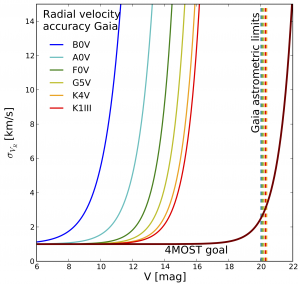Science Overview
As a unique wide-field, high-multiplex, optical spectrograph on a dedicated 4-m class telescope, 4MOST will have a major impact on several key areas of contemporary astrophysics. The near-hemispheric surveys that 4MOST will be able to provide will be of great strategic importance to the European astronomical community, since several key European all-sky, space-based facilities, such as Gaia, eROSITA and Euclid, will only unfold their full potential if complemented by optical spectroscopy of sufficient depth and density. 4MOST will also complement and enhance many existing and upcoming ground-based facilities, including VST, VISTA, the Vera Rubin Observatory, as well as SKA and its pathfinders.

Expected 4MOST radial velocity accuracy compared to the Gaia end-of-mission accuracy as a function of apparent magnitude. The spectroscopic magnitude limits of 4MOST are matched to the astrometric limits of Gaia, thereby enabling 6D phase-space studies to Gaia's limits.
For example, ESA's cornerstone mission Gaia is currently revolutionizing our understanding of the structure of the Milky Way and of its formation. While its astrometric measurements will determine parallaxes and proper motions of >1 billion stars down to G < 20.5 mag, its spectroscopic measurements will be limited to much brighter stars (G < ~15 mag). One of the design goals of 4MOST is to fill this critical magnitude gap over a large fraction of the southern sky. Gaia's spectroscopic limits mean that precise radial velocities can only be obtained within a distance of ~10 kpc even for the brightest stars. With 4MOST we will be able to obtain spectra even for Gaia's faintest astrometric targets, yielding high-quality radial velocities out to 100 kpc as well as metallicities and [α/Fe] ratios of Horizontal Branch and Red Giant Branch stars out to ∼50 kpc. In addition, ages and detailed chemical abundance patterns will be determined for millions of stars. 4MOST will thus enable a large range of Galactic science cases.
Similarly, in 2019 eROSITA began carrying out a full-sky X-ray survey to a limiting depth that is a factor of 30 deeper than the ROSAT all-sky survey, with broader energy coverage, better spectral resolution and better spatial resolution. This survey is expected to discover 3 million X-ray point sources (Galactic and AGN) and about 100,000 extended sources (mainly clusters of galaxies). The full exploitation of this wealth of new X-ray data will require a massive 4MOST spectroscopic follow-up campaign, in order to probe, e.g., the growth rate of structure with galaxy clusters, or to measure AGN evolution and the growth of black holes over cosmic time and its connection to galaxy evolution.
The large galaxy redshift surveys planned with 4MOST will also provide unique constraints on galaxy evolution and cosmology. Linking the low and intermediate redshift Universe, 4MOST will trace the assembly of stellar mass and dark matter halos, and witness the emergence of structures such as groups, filaments and voids over recent times. On the largest scales, clustering measurements of a variety of tracers of large-scale structure will provide high-fidelity constraints on cosmological parameters.
The 4MOST Survey Programme
To enable the science above, 4MOST was designed as a facility for executing large surveys. Hence, for a period of at least 5 years, the VISTA telescope will be dedicated exclusively to observations with 4MOST, and the 4MOST facility, in turn, will be entirely dedicated to a 5-year programme of surveys, with all other types of observations being excluded. Some of these surveys are led and will be conducted by the 4MOST consortium, while others have been initiated by the ESO community. Regardless of their provenance, however, all 4MOST surveys will be ESO Public Surveys, meaning that their science case and scope need to be comprehensive enough to be of significant legacy value to the astronomical community at large, and that their data and advanced data products will become public on relatively short timescales.
Consortium Surveys
70% of the observing time during this 5-year period will be awarded to the 4MOST consortium in return for delivering and operating the facility. This time will be spent on a set of 10 distinct, yet interlocking surveys, collectively known as Consortium Surveys. The planning for these surveys is already far advanced, and a brief overview is provided for both the Galactic and Extragalactic Consortium Surveys.
Community Surveys
The other 30% of observing time will be available to the ESO community. This will allow the community to exploit the many opportunities offered by 4MOST that will not be addressed by the Consortium Surveys. Following an extensive selection process, a set of 15 Community Surveys was selected by ESO in January 2022. These cover a wide range of Galactic and extragalactic science cases and are now in the process of joining the 4MOST Project. Together, the Community and Consortium Surveys jointly form the final 4MOST Survey Programme.